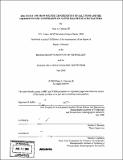| dc.contributor.advisor | Katrina J. Edwards. | en_US |
| dc.contributor.author | Canovas, Peter A | en_US |
| dc.contributor.other | Woods Hole Oceanographic Institution. | en_US |
| dc.date.accessioned | 2007-07-18T14:04:53Z | |
| dc.date.available | 2007-07-18T14:04:53Z | |
| dc.date.issued | 2006 | en_US |
| dc.identifier.uri | http://hdl.handle.net/1721.1/38202 | |
| dc.description | Thesis (S.M.)--Joint Program in Oceanography/Applied Ocean Science and Engineering (Massachusetts Institute of Technology, Dept. of Earth, Atmospheric, and Planetary Sciences; and the Woods Hole Oceanographic Institution), 2006. | en_US |
| dc.description | Includes bibliographical references (p. 64-68). | en_US |
| dc.description.abstract | Salt pond is a meromictic system with an outlet to the sea allowing denser seawater to occupy the monimolimnion while the mixolimnion has relatively low salinity and is the site of greater mixing and microbial activity. The density contrast between the two layers allows for a unique geochemical environment characterized by steep redox gradients at the interface. This chemocline is a habitat for magnetotactic bacteria (MB), and the spatial and temporal distribution of MB in the system along with geochemical (Fe2+, H2S, pH, 02 (aq), etc.) profiles have been analyzed from 2002 - 2005. It has been previously observed that magnetite-producing cocci occupy the top of the chemocline and greigite-producing MB occur at the base of the chemocline and in the sulfidic hypolimnion. This distribution may be attributed to analyte profiles within the pond; depth profiles show a sudden drop of dissolved oxygen (DO) at the chemocline associated with an increase in dissolved Fe (II) concentrations that peak where both 02 and H2S are low. In the sulfidic hypolimnion, Fe (II) concentrations decrease, suggesting buffering of Fe(II) by sulfide phases. | en_US |
| dc.description.abstract | (cont.) Maximum concentrations of iron (II) and sulfide are 3 1 gM and 3 mM, respectively. Stability diagrams of magnetite and greigite within EH/pH space and measured voltammetric data verify fields of incomplete oxidation resulting in the production of elemental sulfur, thiosulfate and polysulfides. Calculations of the Gibbs free energy in the Salt Pond chemocline for potential microbial redox reaction involving iron and sulfur species indicate abundent potential energy available for metabolic growth. Oxidation of ferrous iron to ferrihydrite in the upper region of the chemocline consistantly has a yield of over -250 kJ/mol 02 (aq), - 12.5 times the proposed 20 kJ/mol minimum proposed by Schink (1997) necessary to sustain metabolic growth. This translates into biomass yields of ~ 0.056 mg dry mass per liter of upper chemocline water. If these numbers are applied to the dominant bacteria of the chemocline (MB that are 3% dry weight iron) then there could be up to ~ 1.68 mg of iron per liter of upper chemocline water just in the MB. | en_US |
| dc.description.abstract | (cont.) This iron can be permanently sequestered by MB into the sediments after death because the organelles containing the iron phases are resistant to degredation. Geochemical and microbial processes relating to the cycling of iron heavily impact this system and perhaps others containing a chemocline that divides the water column into oxic and anoxic zones. | en_US |
| dc.description.statementofresponsibility | by Peter A. Canovas, III. | en_US |
| dc.format.extent | 145 p. | en_US |
| dc.language.iso | eng | en_US |
| dc.publisher | Massachusetts Institute of Technology | en_US |
| dc.rights | M.I.T. theses are protected by copyright. They may be viewed from this source for any purpose, but reproduction or distribution in any format is prohibited without written permission. See provided URL for inquiries about permission. | en_US |
| dc.rights.uri | http://dspace.mit.edu/handle/1721.1/7582 | |
| dc.subject | /Woods Hole Oceanographic Institution. Joint Program in Oceanography/Applied Ocean Science and Engineering. | en_US |
| dc.subject | Earth, Atmospheric, and Planetary Sciences. | en_US |
| dc.subject | Woods Hole Oceanographic Institution. | en_US |
| dc.subject.lcsh | Oxidation-reduction reaction Massachusetts Salt Pond | en_US |
| dc.subject.lcsh | Magnetite Massachusetts Salt Pond | en_US |
| dc.title | The redox and iron-sulfide geochemistry of Salt Pond and the thermodynamic constraints on native magnetotactic bacteria | en_US |
| dc.type | Thesis | en_US |
| dc.description.degree | S.M. | en_US |
| dc.contributor.department | Joint Program in Oceanography/Applied Ocean Science and Engineering | en_US |
| dc.contributor.department | Woods Hole Oceanographic Institution | en_US |
| dc.contributor.department | Massachusetts Institute of Technology. Department of Ocean Engineering | |
| dc.identifier.oclc | 71337373 | en_US |
